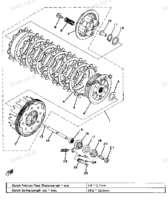Or put a magnet against the pushrod, and it will pull the ball out if you go slow. I have a strong magnet for things like this. Works well. The ball will have to be pulled from the clutch side, it won't make it through the seal side.
The easier way to tell is where the pushrods seal has been rubbing on the rod on the left side. If the seal is is riding on the rod where it has polished it, and not where the rod is much farther in, then the ball must Be in there.
Proper adj has been covered: put all slack back into clutch cable at lever; undo lock nut under rubber plug on left side, turn adjuster in until it touches rod, back off 1/6-1/4 turn, take your pick, the tighten locknut. Then adjust cable properly. You're done. If clutch drags, either plates are warped, or oil is goo. Try oil first. If still drags, or slips, new plates time. Up front, I'd suggest Yamaha or Barnett plates. Both will last 30 years. Off brand stuff will not.
I believe you're over thinking this.
Keep the final oil change to really good oil until after you're done pulling things apart. No use dumping fresh expensive oil. Don't use car oil. I happen to use Mobil1 Racing4T 10-40 in all of my bikes, but there are other good oils. Just be sure they say rated JASO MA. I tend to favor true synthetics as these engines run quite warm, it just kills regular oil off sooner. Synthetics can take it.


 I bought my plates off of the
I bought my plates off of the 